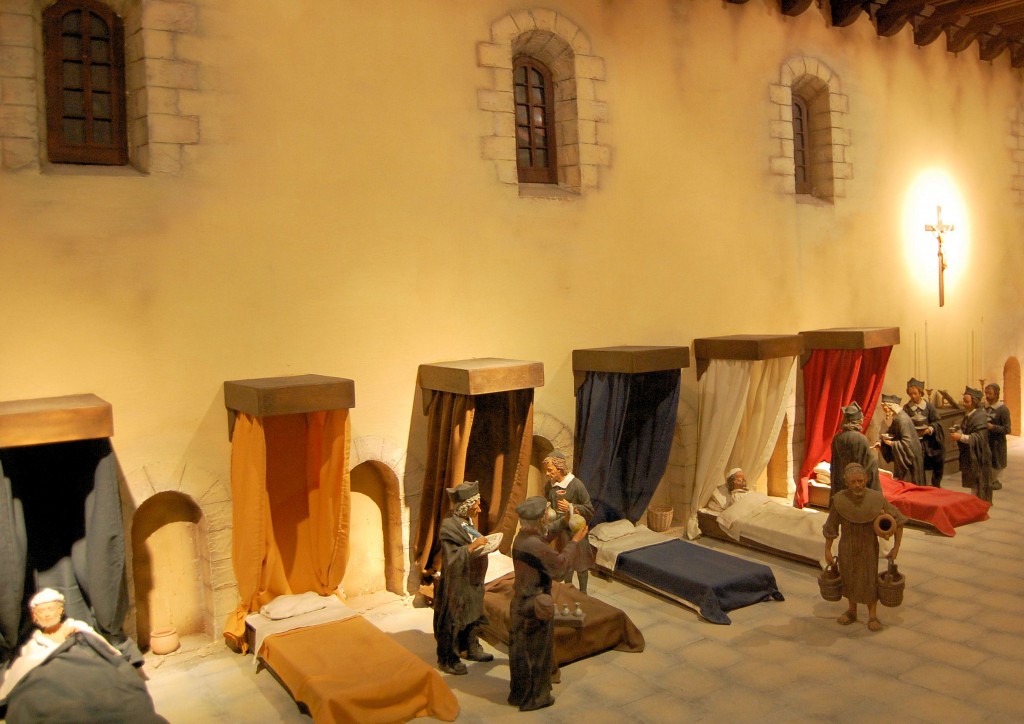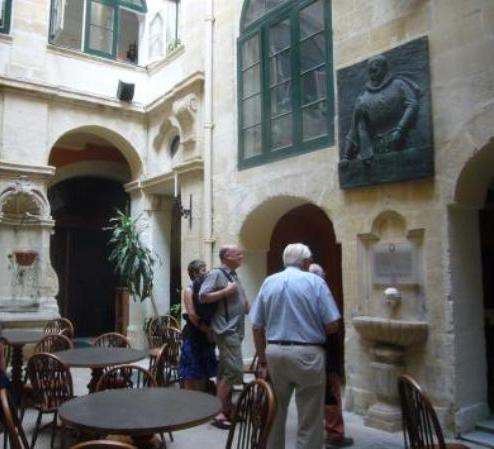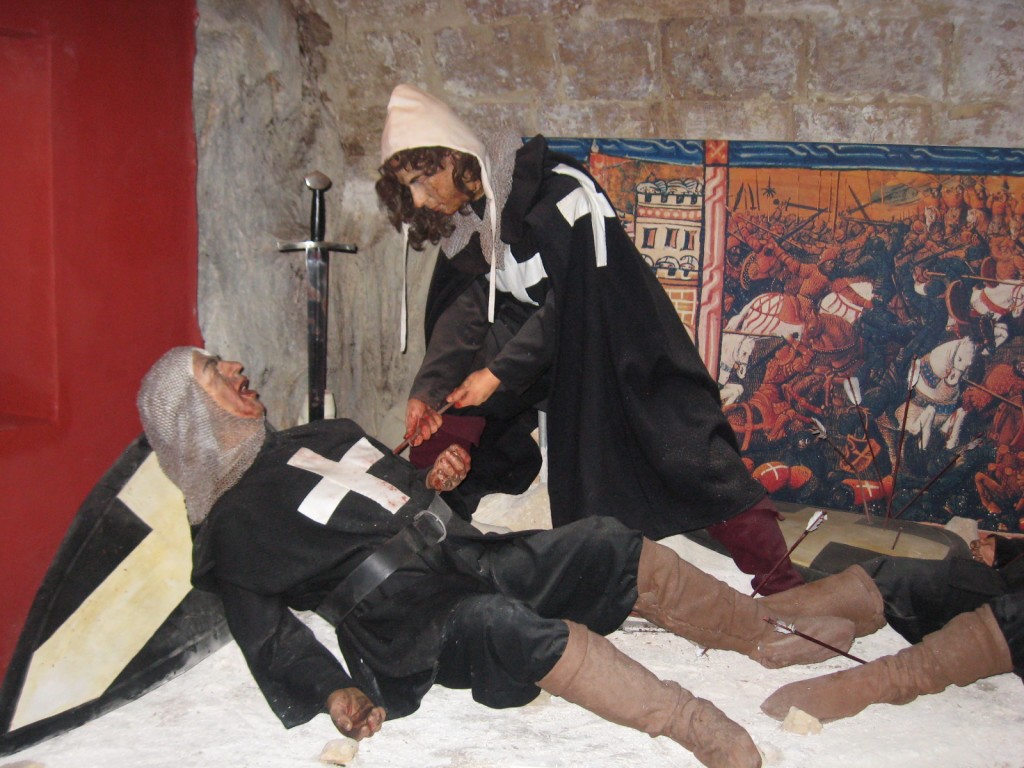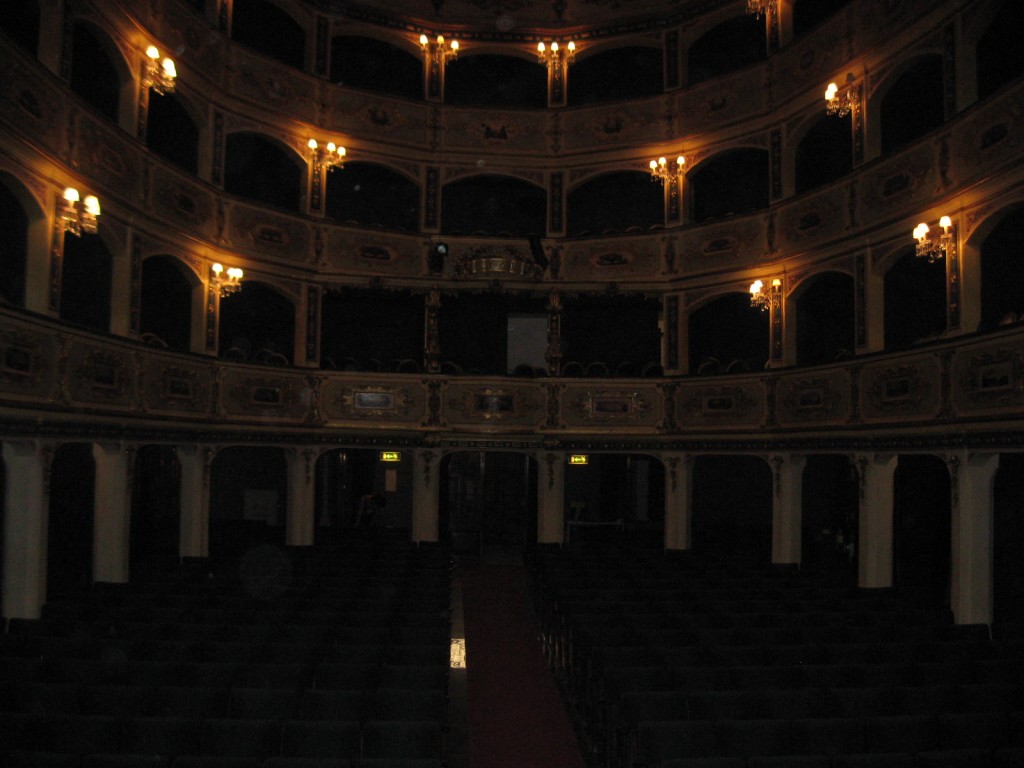Today, while puttering around the kitchen making breakfast watching the morning grow ever later, I decided to visit some of the museums and attractions in Valletta that I hadn’t yet seen. My first stop was the War Museum because it was probably as far from my apartment as any site in Valletta on my list of places to visit. On foot, it was an “exhausting” walk of 12 to 15 blocks that took at least ten minutes.
The museum covers the two World Wars of the twentieth century but I focused most of my time there on WW II and the second siege of Malta. Some highlight facts starting with a somewhat quirky one:
The need to conserve fuel led to the extensive use of horse cabs. These cabs are ubiquitous in Valletta today but I was unable to learn if their presence pre-dated the war or if their continued use is a carryover from that time.
On the not so quirky side of the ledger:
Air and submarine attacks from Malta disrupted German supply lines. Thus Malta played a crucial role in the battles for North Africa between Rommel and Montgomery. Over the course of the war, Maltese submarines sank over 400,000 tons of Axis shipping.
In April 1942, the Axis flew 9,599 sorties over Malta and dropped 6,727 tons of bombs. The total tonnage of bombs dropped on Malta exceeded 15,000 – more than any place other than Britain during the blitz (about 18,000 tons).
Over 10,000 public and private buildings were destroyed and another 19,000 were damaged. Malta suffered 1,581 civilian casualties or close to 6% of its population of 270,000. More than 1,400 of these occurred in the April 1942 assault. Malta also suffered another 7,500 military and merchant casualties.
The British funded much of the rebuilding with 30,000,000 Pounds Sterling. Churchill and Roosevelt met in Malta prior to their meeting with Stalin in Yalta. The Maltese people were given the Order of King George in recognition of their many sacrifices.
My next stop took me to the Sacra Infermeria (Holy Infirmary) and Knights Hospitallers back on the northwest side of the city near the Lower Barrakka Gardens.
I’ve mentioned the Knights Hospitallers before and promised more detail and now is the time.
The Order of the Knights of Saint John was officially recognized by Papal Bull in the 12th century after the conquest of Jerusalem in the First Crusade. They remained there until Islamic forces captured the city in the late thirteenth century then temporarily relocated first to Acre and subsequently to Cyprus. The Knights sought their own domain and eventually conquered Rhodes early in the 14th century during which time they were also known as the Knights of Rhodes. When Rhodes fell to the forces of Suleiman in 1522 the Knights withdrew to Sicily and for seven years were somewhat itinerant until in 1530, King Carlos V of Spain granted them a perpetual fiefdom over Malta and Gozo provided they made an annual payment on All Saints Day of (and I hope you’re ready for this) one falcon.
The Great Siege of Malta occurred in 1565 when a force of approximately 40,000 Ottoman Turks led by Suleiman the Magnificent sought to once again dislodge the Knights. However, the Knights, led by Jean Parisot de la Vallette together with a force of about 5,000 or so Maltese held off the Turkish force through several great attacks. After the Knights fended off an assault in August, the Viceroy of Sicily sent a small force of reinforcements and the dispirited Turks withdrew on 8 September.
In the fourteenth century, the Knights had organized themselves into seven Langues or Tongues each representing a geographic or cultural subgrouping of its members. I mention this because it will have some significance when I visit Saint John’s Co-Cathedral later today.
Following their victory over Suleiman’s forces and for the remainder of the 16th century and much of the seventeenth, the actions of many of the Knights were shall we say reportedly mercenary and lascivious. However, some hearkened back to the Order’s original purpose and they created a military and civilian hospital that served the island through the Great Siege and an outbreak of bubonic plague in the late seventeenth century. They continued to do so until they were dispersed after Napoleon’s conquest of Malta in 1798. They are credited with giving birth to some of the concepts of modern-day medicine, nursing, and health care.
The museum is filled with wax figure representations of care both military
and civilian.
 Another highlight of this space is the Grand Ward which is nearly 150 meters long and which you can see here.
Another highlight of this space is the Grand Ward which is nearly 150 meters long and which you can see here.
Stop number three was the Teatro Manoel. This is the third oldest working theater in Europe. All tours of the theater are guided and scheduled hourly. In typical Maltese fashion, the woman who leads the tours is also the person who sells the tickets so the office looks abandoned until about 10 minutes prior to the tour. I got there early and sat sipping a Cisk in the courtyard café. 
The theater was commissioned in 1731 by the Grandmaster of the Knights of Malta. Opening in January 1732 as the Teatro Publicco, it has been in continuous use in one form or another (though not always as a theater) since that time. There are about 600 seats in the theater and as with much of Malta the plain somewhat worn exterior belies the rich rococo interior.
Here are some facts quirky and otherwise I learned about the theater. (Almost every place you visit in Malta has quirky facts.)
Until the last quarter of the eighteenth-century, companies rather scandalously slept in the boxes of the theater until the practice was banned.
When Napoleon conquered Malta in 1798, his administration appointed the first Maltese theater manager – a famous composer Niccolo Isouard.
At some point early in the nineteenth century, it was renamed Teatro Reale.
In 1811 or 1812 the interior was refurbished and changed from stone to wood to improve the acoustics and in 1844 paintings were added to the boxes. (The shot below looking out from the stage is dark because the theater was dark.)
The theater fell into some disuse in the mid-1860s when the British built the Royal Opera House and was used as housing for the poor until the Opera House burned down in the 1870s. At that time the theater was revived until the Opera House was rebuilt. It became a movie theater for about 20 years in the early 20th century. During WWII it served as a temporary shelter for people made homeless by the relentless bombings and again saw its revival as a theater when the Opera House was destroyed by those selfsame bombs. The theater is in use today but since it’s generally dark during the summer months I’d have no opportunity to attend a performance there.
After the tour, I sat and shared lunch with a British chap named Hugh who had lived in Malta as a teen and was visiting with his sister and mother. While Valletta has retained its character, he lamented the new construction overtaking Sliema because he feels it has changed the character of that place. He also warned me of an eyesore at Marsaxlokk.
I had two more stops planned before ending my Valletta sightseeing day. The first was at the Museum of Archaeology where I learned among other things that the Temples at Ggantija on Gozo predate the Acropolis in Athens by 3,000 years, Stonehenge by 1,600 and the Great Pyramid by 1100.
Ggantija was one of three places I’d wanted to see on Gozo (the others being Calypso’s cave and the salt pans) but, as things turned out, I wouldn’t push my schedule to return there. The Valletta museum houses the original of both the Sleeping Lady carving found in the Hypogeum (which I will visit tomorrow) and the Venus of Malta statuette discovered at Hagar Qim where I will visit later in the week.
My final stop was Saint John’s Co-Cathedral about two blocks from the flat. Again, the simple exterior belies the intensity of the baroque interior. This is another place with no flash photography allowed so, like the archaeological museum, my photos are generally dark though I did figure out late in my visit how to keep the shutter open for better exposures and managed a few without my hands shaking. The cathedral is certainly impressive – if this sort of thing impresses you.
I returned to the flat for my nightly rooftop interlude then prepared a light dinner of salad with kippers and figs. I stopped to visit with Patrick who was kind enough to let me use his computer to check my email. He and Diane were so hospitable I ended up sitting and chatting while we watched the Euro Cup soccer match between England and Ukraine and shared another Cisk or two that Diane kindly offered. We talked about movies, about ways he could use the internet to help his business, and a few other topics. After the game, and by that time it must have been close to midnight, I stumbled down the stairs and collapsed into bed.





Todd
What were the mercenary and lascivious things the Knights got up to?
John
Well, I can’t speak with specificity to the lascivious acts of the Knights but they did become known for raiding and plundering Muslim ships in the Mediterranean in the 16th & 17th centuries which apparently got quite out of hand. I also remember reading about the Knights returning from these raids to “indulge in some of the pleasures of a traditional debauched seaport.”